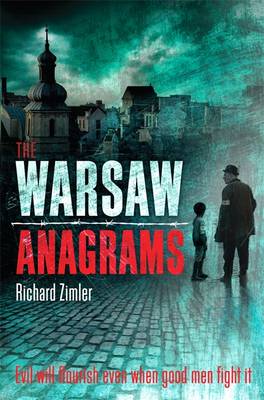
EURO CRIME
Reviews

Zimler, Richard - 'The Warsaw Anagrams'
Paperback: 336 pages (Feb. 2011) Publisher: Corsair ISBN: 1849013697
It is the bitterly cold Autumn of 1940 and Erik Cohen, an elderly retired psychiatrist, is forced to move into an area within Warsaw that the Germans have created, to locate all the 400,000 Jews of that city. Erik is obliged to live with his niece and his beloved nine year old nephew, Adam, in a tiny flat. One, extremely cold day, Adam goes missing and after searching all over the place and questioning all their contacts, finally, the next day his body is found naked and entangled in the barbed wire fence that surrounds the ghetto. The boy's leg has been hacked off and a tiny piece of string has been left in his mouth.
Erik and niece are obviously, very upset about all of this and even more so, when a young girl's body is located also with one of her hands missing. Erik and his close friend Izzy start to look into all the possible clues associated with this, as both men feel that as Jews their lives are very limited and they need to ensure that all the children living in the ghetto are as safe from death as possible. It was a truly depressing time, the Germans having made an island where they control who goes in and out and what food and everything else goes in and out. This island is encircled with barbed wire and the only access points are guarded night and day by their armed soldiers. The inhabitants of the ghetto have to sell off all their possessions gradually, to buy food to live, as they get no income otherwise and as they do not know individually how long they will live, they have to go without and suffer the resulting hunger. As they cannot get any coal, even if they could afford it, as all possible supplies are cornered by the Germans to help the war effort, in this bleak Winter it is bitterly cold and they are having to burn furniture, or anything flammable in their fires to keep out the cold. But of course there is only a finite amount of furniture.
Erik discovers that the two dead children were members of a choir, he suspects that adult members of the same group could be involved in the deaths and then it becomes apparent that the girl who was killed was expecting a baby, the father of whom, was a gentile (a non Jew) living outside the ghetto. Erik wants to check that out more and needs to leave the ghetto to do so, which is very difficult and the preparations he makes are explained in detail. He needs to get fake papers forged by a criminal he knows, as he will have to go through a German check point. He decides to take Izzy along with him, which presents other difficulties. So as it goes on the two main characters have many adventures until at last the murderer is discovered and dealt with, but it doesn't end in a nice way.
I found this a deeply moving book. It deals with the Second World War but with an aspect of it that is not discussed too often, and the author has researched his subject extremely thoroughly and his characters live with much deprivation in the ghetto. I consider this book the best and most moving one that I've read for some time and I was deeply affected by it. This is the seventh book written by this author who indicates in a dedication at the beginning that many of his grand-uncles, aunts and cousins perished in the ghettos and camps of Poland during the War. A truly wonderful book, which I will not forget.
Terry Halligan, England
April 2011
More crime fiction reviews can be found on the Reviews page.